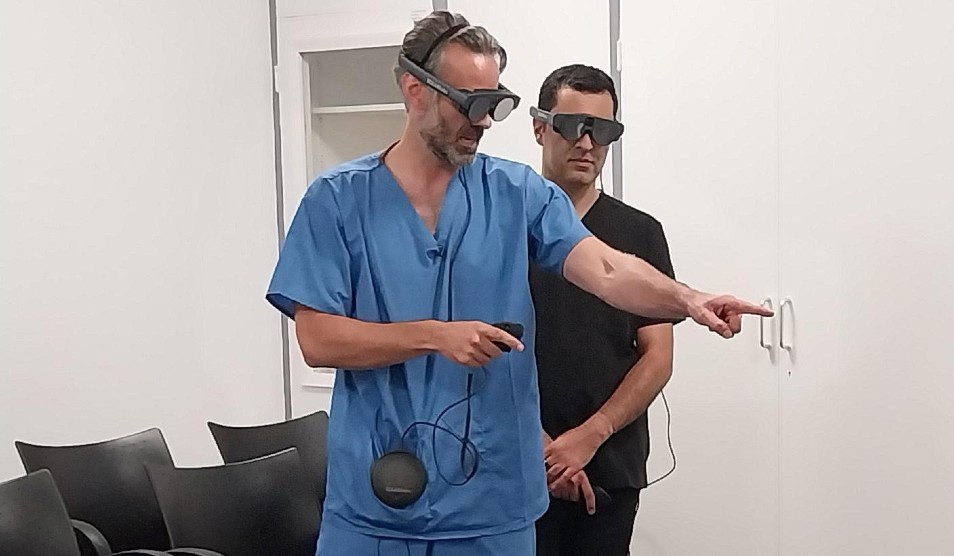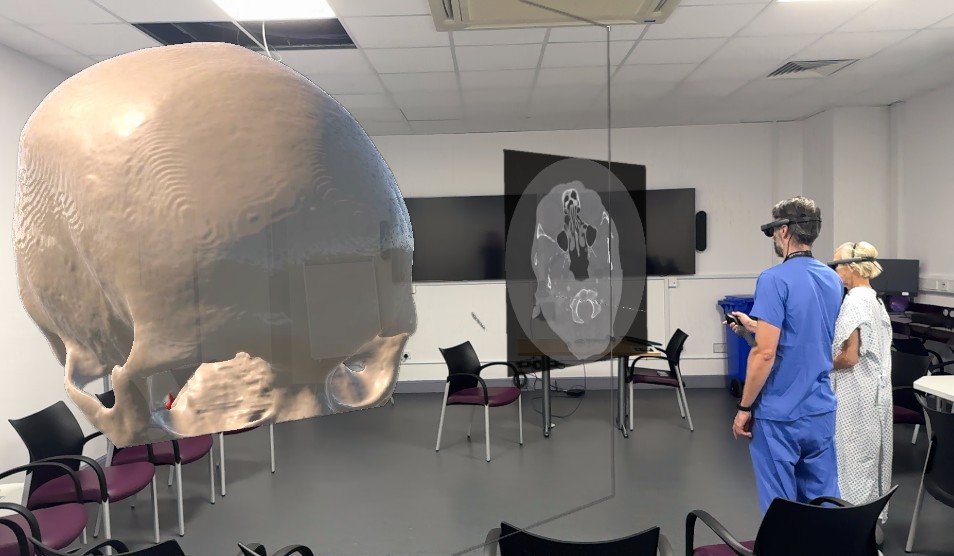NHS neurosurgeons introducing cutting-edge, mixed reality technology to improve care
The neurosurgery team at Imperial College Healthcare NHS Trust is introducing cutting-edge, mixed reality technology into parts of their day-to-day work to improve training and patient care. The technology allows clinicians and patients to view and interact with high-resolution 3D hologram-like images of patient scans, alongside traditional imaging techniques. It is being used to support some patient consultations, assist preparations for certain operations and provide immersive clinical training.
Mixed reality, which blends 3D digital content with the real world, is regarded as the next frontier in visual computing. It enables users to interact with digital content - such as 3D renderings of patient scans - while remaining fully aware of their real-world surroundings. Unlike Virtual Reality (VR), which immerses users in a completely separate 3D environment and blocks out the real world, mixed reality enhances the user’s perception by integrating digital and physical elements. The Trust’s neurosurgery team utilizes XARlabs’ simXAR mixed reality tool, which was developed independently by a registrar at the Trust when he was part of the NHS Clinical Entrepreneur Programme, prior to joining the Trust.
The simXAR technology was initially planned to support training within the neurosurgery department with funding from NHS England. The Trust neurosurgery team recognised the broader benefits the technology could offer patient care - and introduced it in some consultations in order to better explain proposed treatments to patients as part of the consent process and also used it more widely to enhance team preparedness.
The team uses the technology to convert CT and MRI patient scans into 3D augmented reality models. During training sessions and certain patient consultations, both the surgeon and the trainee - or the surgeon and the patient - wear Trust-owned Magic Leap 2 headsets. Patients provide consent for both the generation of their models and for wearing the headsets. The surgeon can interact with the 3D model by zooming in, rotating it, or even ‘walking’ inside to visualise the patient’s anatomy in an immersive and easily understandable way. This marks a significant shift from the traditional method of viewing scans one series at a time on 2D computer screens. The team believes this represents an innovative way of viewing medical imaging that can significantly benefit both patients and health professionals in the NHS.

The neurosurgery team at Imperial College Healthcare is primarily using the simXAR technology in training and simulation sessions and has also begun inviting some patients to view their 3D models before surgery to help them better understand the planned procedures. The technology is also being used alongside conventional scans to enhance the team's ability to view and understand the surgical anatomy ahead of certain brain and spine operations. Additionally, the team is looking to assess the technology’s potential broader benefits in medical training, patient experience, and surgical guidance, subject to ethical and regulatory approvals.
Mr Arthur Dalton, consultant skull base and vascular neurosurgeon at Imperial College Healthcare NHS Trust, said: "We immediately saw the potential of this technology and set out to develop a world-class mixed reality suite, drawing on the expertise and innovation within our own surgical team. The level of detail and interactivity it offers far surpasses traditional methods, facilitating better preparation and understanding for surgeons, trainees and patients.
"We're already starting to see benefits as we continue embedding this system into our work. The potential for improving patient care and training is huge. We believe we are the first, or one of the first, to adopt this type of mixed reality platform in this way in the NHS and hope our work can help the NHS remain at the forefront of this emerging technology. "
Mr Ali Haddad, senior neurosurgery registrar at Imperial College Healthcare NHS Trust, an alumni of the NHS Clinical Entrepreneur Programme and founder and CEO of XARlabs, said: "We are thrilled to be pioneering this innovative technology at the Trust, and are really excited about the potential for improving patient care. We believe it marks a significant advancement in the integration of mixed reality technology within the NHS.
"The technology allows us to visualise and rehearse surgical procedures with great detail and accuracy, which we believe brings quantifiable benefits to both patients and clinicians. We are also looking to explore how the technology could benefit surgeries in real-time in the future, hopefully undertaking clinical trials within the next couple of years.”
Patient case studies
Matthew
Matthew was admitted to the neurosurgery department at Charing Cross Hospital in 2023, following a subarachnoid haemorrhage, a serious type of brain haemorrhage. Diagnostic scans revealed two aneurysms in his brain, one of which had ruptured. He successfully underwent surgery to clip both aneurysms. After his recovery, the medical team used pre- and post-operative scans to create their first highly detailed 3D augmented reality model. This model has since been utilised in training sessions to educate some of the next generation of surgeons on the principles and techniques of aneurysm surgery.

On seeing his 3D model for the first time, Matthew said: "I'm so grateful to Arthur and his team for saving me last year and want to do everything I can to help other patients.
"I didn't know quite what to expect before trying the headsets in person for the first time. But it's been really cool seeing it, especially seeing everything in such detail. Everyone did a great job explaining my diagnosis and treatment when I was in hospital. But it wasn't possible to visualise it quite like you can with the headsets, which I think could have helped me.
"It means a lot knowing my scan is being used to help train future neurosurgeons - and ultimately helping other patients."
Jacqueline
Jacqueline was one of the first patients to benefit from the technology ahead of her surgery. The 3D augmented reality model was used during her consultation to clearly explain the planned procedure, aiding both her understanding and the surgical team’s preparation. She had a brain aneurysm, which was successfully treated in a complex operation in August. She is now back home and recovering well.
While the surgical decisions and treatment plan were based on the Trust’s existing imaging and software, the mixed reality technology provided a much clearer and more accessible view of the aneurysm. This enhanced Jacqueline’s understanding of her condition and enabled her to give informed consent with greater confidence.

